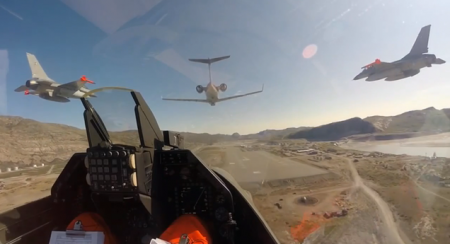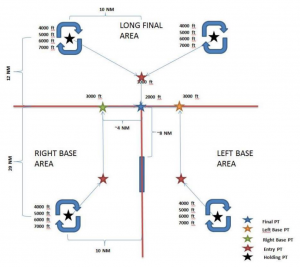Difference between revisions of "ATC Vector Visual"
BibleClinger (talk | contribs) |
BibleClinger (talk | contribs) |
||
| Line 1: | Line 1: | ||
| − | [[File:F16-approach.png|alt=F-16 and other aircraft low over runway|frameless|right|upright=1. | + | [[File:F16-approach.png|alt=F-16 and other aircraft low over runway|frameless|right|upright=1.5]] |
=Learning objectives= | =Learning objectives= | ||
Revision as of 17:35, 22 July 2019
Contents
Learning objectives
- Know how to enter the pattern for a Visual Approach
- Understand the directions of ATC
- Know how to deal with breaches in the protocol
The Approach
Pros
- ATC can manage large numbers of both human and AI traffic at the same airbase.
- Pilots are processed in an orderly fashion. Everyone is guaranteed a slot to land eventually.
- Entire flights are handled in the same fashion. (With other approaches, humans and AI are treated as separate entities.)
Cons
- When the pattern is busy, vectoring can consume more fuel.
- This style of approach takes longer than others.
- There is a chance of being kicked out of the queue and being made to wait even longer.
When Things Go Right
Flights should enter the pattern, follow ATC directives, and land safely. This is the ideal circumstance. Flying in close proximity with many aircraft, however, is rather dangerous if protocol is not kept.
Entering the Pattern
- Flights shall arrive within 30nm of the Destination Airbase to be in range of ATC Approach airspace.
- Flight Leads shall order their flight to switch to the appropriate Destination Approach Preset or Frequency. This is usually UHF 4, UHF 7, or UHF 10.
- Flight Leads shall request vectors for visual approach. This enters all members of the flight in the ATC Queue, as long as they are within 5nm of the flight lead.
Note: It is important that all pilots in the flight are tuned to the appropriate frequency prior to requesting vectors. They will not hear ATC giving them vectors if they are not on the correct frequency.
ATC may give you information on initial contact, such as QNH. Each pilot should use this information and set the altimeter accordingly!
Following Pattern Directions
The ATC will vector each member of the flight individually. The radio chatter on the ATC Approach frequency can get busy rather quickly. If an airbase has 4 full flights returning, that is 16 different aircraft that ATC is vectoring concurrently. Each pilot must listen carefully for his callsign to be called. It is imperative that each member of the flight follow every directive as quickly and as safely as possible to avoid a collision.
The ATC's instructions to a pilot will start with the pilot's callsign and will reference up to three variables:
- Heading
- Altitude
- Speed
An example directive might be, "Plasma 1-1, turn right heading 355. Descend to 5000. Maintain 300 kts." In this scenario, all three variables are explicitly mentioned. This is not always the case. All pilots will need to listen to the exact directive given to them while remembering what was given by ATC prior. Again, pilots must obey the directives as soon as possible in the safest manner.
If a pilot misses the directive, he may issue a "Say again" request to ATC Approach.
Understanding the Pattern
The ATC may ask a pilot to orbit for spacing at a given altitude. An example directive might be, "Falcon 2-2, orbit for spacing. 6000." This is a directive to begin a right-hand orbit at 6000ft. If a pilot is asked to orbit above 4000ft, he may expect that there is traffic below him.
Eventually ATC will begin appending the landing runway to the directives. "Viper 1-3, turn heading 305. Descend to 4000. Maintain 270 kts. Vectors to final. Runway 18." This is letting the pilot know he's getting close to being handed off to ATC Tower.
On Final
Once ATC Approach tells a pilot to contact Tower on Final, the pilot should switch to the ATC Tower preset or frequency. This is typically UHF 3, UHF 8, or UHF 11. When he is within 6nm of the airbase and within 30° of either side of the threshold, the pilot must contact Tower and report "On final."
If all is good, Tower will give clearance and repeat the landing runway.
Note: It is NOT necessary to request landing clearance from the Tower. The pilot has already been entered into the ATC Tower Queue via ATC Approach. The Tower is expecting him to report that he is on final approach.
When Things Go Wrong
With this many aircraft in close proximity, it is possible for disaster to strike. A pilot must maintain his Situational Awareness at all times.
Traffic Advisory Calls
Occasionally, ATC might inform you about incoming traffic. If ATC makes such a call, then ATC is concerned this traffic may be on a collision course with you.
A traffic advisory call might sound like, "Fury 1-3, traffic 11 o'clock."
- A pilot should immediately look in the direction cited. In the example case, it is 11 o'clock, which is to the front and slightly left of the pilot.
- Visual contact should be established with the traffic in question.
- The pilot must quickly make an informed decision if he needs to deconflict with the approaching aircraft. This is an incredibly dangerous situation, and such a decision should not be taken lightly. It is always better NOT to change course if it is not needed.
- Once a pilot has established visual contact with the traffic, is aware of the situation, and is no danger, he may issue a "Traffic in Sight" reply to ATC.
'''Note:''' ''ATC will continue to warn the pilot about traffic until ATC is confident that the danger is over or the player acknowledges that he has the situation under control. A pilot may miss critical directives and be forced to abort his approach if he does not actively inform ATC that he has the traffic in sight.''
Authorization Canceled
ATC may cancel a pilot's approach. The solution to this is to re-enter the queue all over again. A pilot must request approach all over again as he begins flying outside of the immediate vicinity of the airbase. This cancellation of clearance might be due to flying too close to traffic, or disobeying directives.
If you absolutely cannot abort, you may declare an emergency.
'''Note:''' ''Declaring an emergency is a very serious decision, as it disrupts the queue. A pilot should never do this simply for convenience.```
Not Reporting Final
While not reporting final can be seen as a simple oversight, it is not. It disrupts the Tower's queue. The tower is expecting you to land, but he doesn't know where you are exactly in relation to the other landing aircraft. When a pilot performs a landing without authorization, he puts the other flights at risk.


